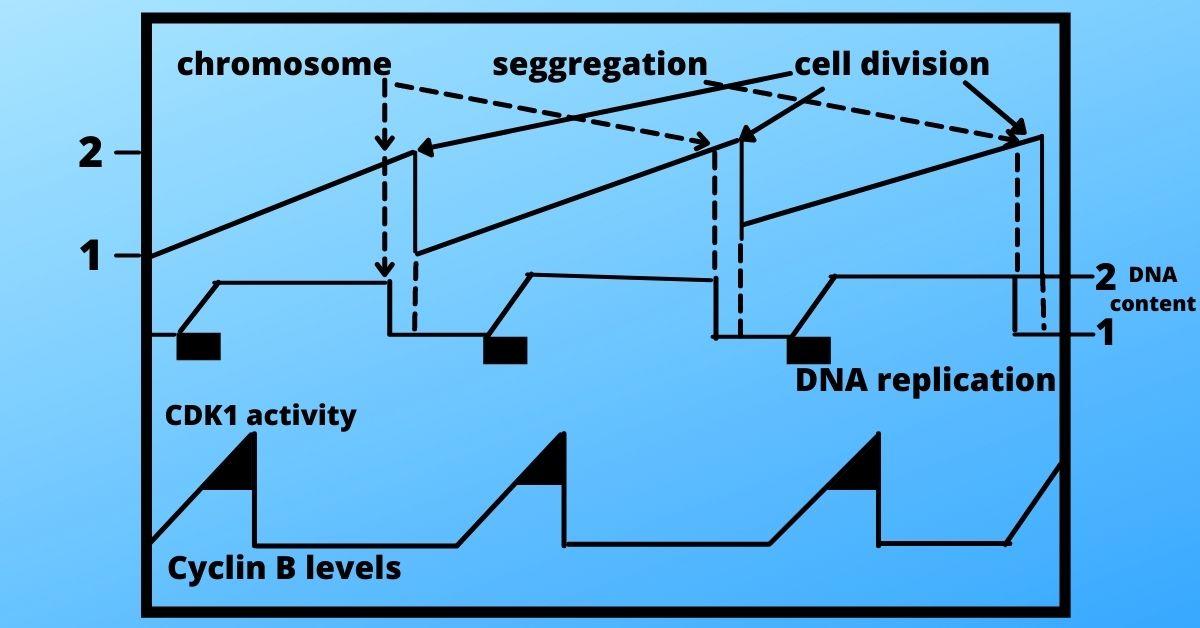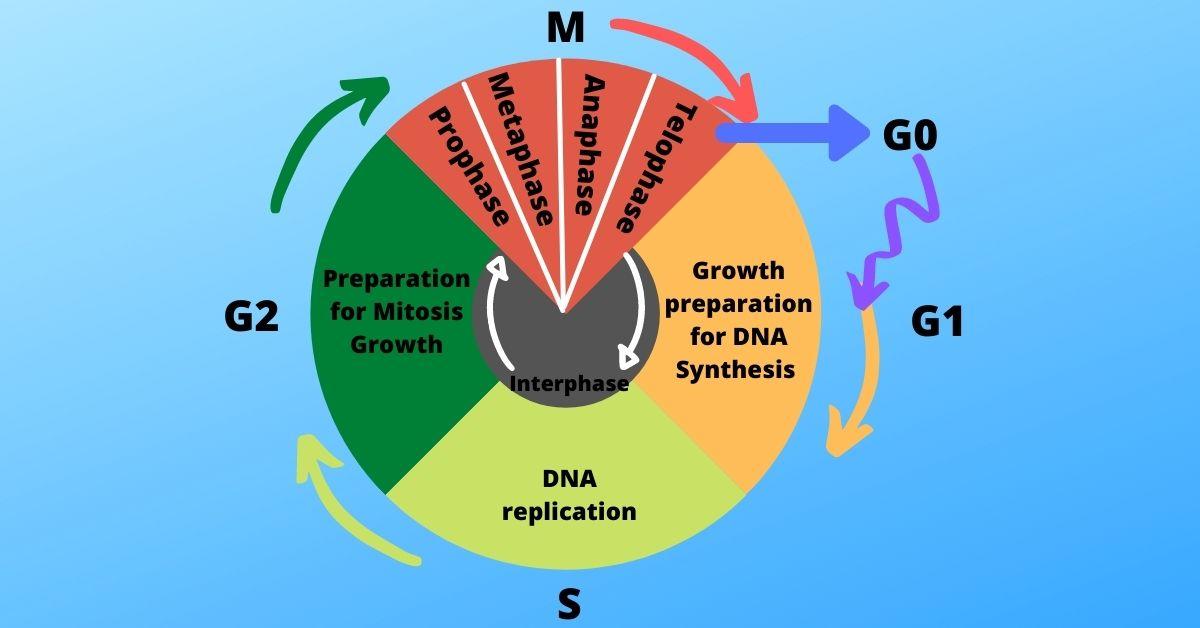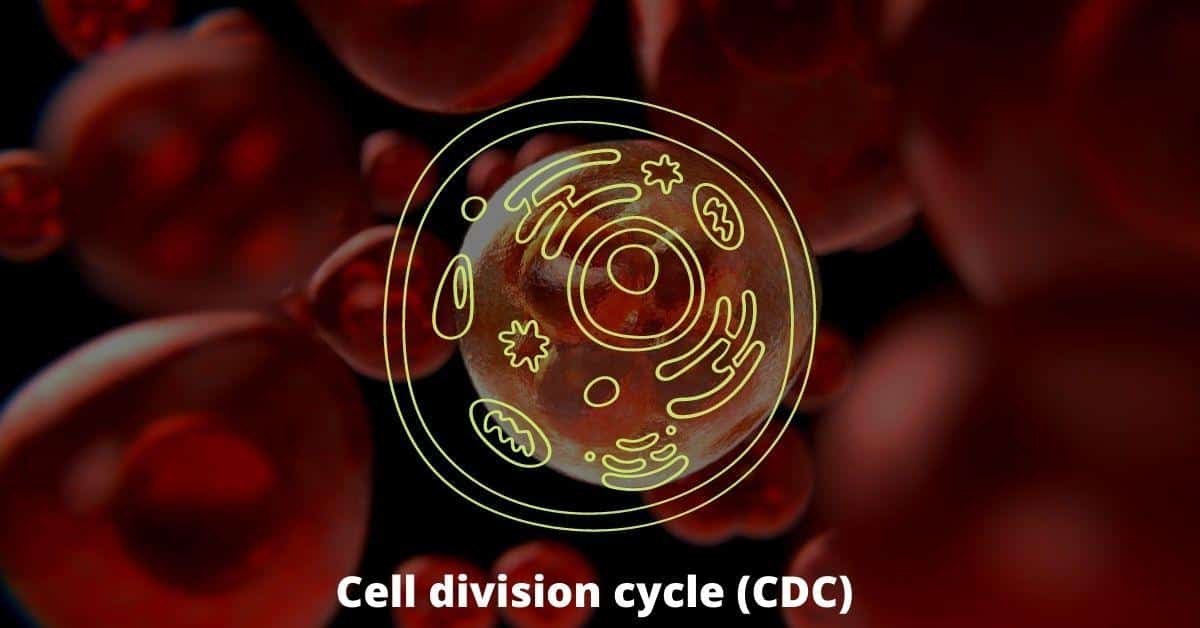The series of events in a eukaryotic cell between one cell division and the next division is called as Cell division cycle. Thus, it is the process by which a fertilized egg develops into a mature organism and the process by which different types of cells and some internal organs are renewed. The cycle derived daughter cells are the same as the starting mother cells.
phases of cell division cycle
The cell cycle consists of four distinct phases:
- G1 phase
- S phase
- G2 phase ( G1/S/G2 collectively known as interphase)
- M phase
M phase is composed of two tightly coupled processes mitosis and cytokinesis :
- Mitosis, here the two daughter cells’ chromosome divided, and
- Cytokinesis, in which the cell’s cytoplasm physically divides.
The cells whose divide process have temporarily or reversibly stopped, this sign means they have entered a state of quiescence called G0 phase, but when the cells have permanently stopped dividing due to age or sometimes accumulated DNA damage, then they are said to be senescent. Some cell types in mature organisms enter the G0 phase semi-permanently and can only be induced to begin dividing again under very specific conditions or circumstances. In other types, such as in the meristematic tissue, cells continue to divide throughout the plant life.
Few stages of mitosis are prophase, metaphase, anaphase and telophase. The chromosome cycle of chromosome duplication and segregation, S phase and M phase is very much coordinated but non-overlapping.
The molecular events that control the cell cycle are ordered and directional, that is, each process occurs in a sequential manner and is irreversible. There are two key classes of regulatory molecules that determine a cell’s progress through a cell cycle: cyclins and cyclin-dependent kinases. Hartwell, Hunt and Nurse won the 2001 Nobel Prize in Physiology and Medicine for their discovery of these central molecules in the regulation of the cell cycle.
Chromosome duplication occurs in S phase
All the DNA must be copied faithfully exactly once and it must occur in a timely fashion. Duplicated chromosomes must remain attached to allow subsequent cell cycle events (i.e. cohesion). Chromosome segregation occurs during the M phase. During prophase, chromosomes condense or pack to allow more efficient movement. The cell must assemble a mitotic spindle. At metaphase, the chromosomes align upon a spindle, attached via their centromeres to microtubules. After attachment and organization of all the chromosomes, they are segregated by releasing cohesion that attaches the sisters together, and reeling in the spindle (anaphase) until they decondense and form new nuclei (telophase).

The orderly progression of events is finely regulated so that the nuclear cycle is coordinated with cell growth and physical separation. Replication process must occur once in each cell cycle and then proceed to the next step, that is, chromosome segregation and the segregation step must be complete before cytokinesis.
G1 phase (First gap)
In this phase, the cell carries on its usual metabolic activities while preparing to duplicate its DNA. These preparations include cell growth by increasing the amount of cytoplasm and the number of important organelles like mitochondria. In G1 a diploid cell has a complement of 2N chromosomes, where N is the gene copy number. In case of some organisms where sexually reproduction occurs, there this amounts to one chromosome inherited from each parent. The actual quantity of DNA, described by many scientists, as 2c, where the ”c” value is measured in picograms and the measure of 1c is equal to the quantity of DNA in a single haploid genome segment. The end of G1 is demarcated by a specific term as a ”point of no return” beyond which the cell is committed to dividing; in yeast, this moment is called as START and also termed as the restriction point in multicellular eukaryotes.
S phase (synthetic phase)
In the S phase, the cell duplicates its DNA material and also occurs as a duplication of the centrosome.
G2 phase (second gap)
In this phase, the cell continues with growth and metabolism in preparation for undergoing mitosis. In G2 the DNA content within the cell is increased to 4c, but the cell is still considered diploid.
M phase (Mitotic phase)
In M phase the cell segregates it’s chromosomes so that both daughter cells receive a total complement of 2N. The four stages of mitosis – prophase, metaphase, anaphase and telophase – also progress in a sequential and vectorial fashion, like the cell cycle as a whole. The final stage of mitosis is termed as Telophase that is also accompanied by cytokinesis. After cytokinesis the cell cycle is complete and the new daughter cells are said to be in G1 again. The exact mechanism of cytokinesis is highly dependent on the type of cells and organisms, for example, in plant cells surrounded by a rigid cell wall, thus by the process of cell plate formation, here cytokinesis occurs. while in case of animal cells are ”pinched” in two by a ring formed from a structural protein called actin.
So, M phase is a time when the cell is directed towards activities necessary for cell division – a time when the synthesis of macromolecules is generally shut down. In contrast, interphase is a period when a cell often grows in volume and carries out active metabolic functions, such as glucose oxidation, transcription, translation and replication.

Interphase
Interphase is the period from the end of one cell division to the start of the next division. This phase is characterized by a high rate of metabolism involving both protein and nucleic acid synthesis. All the protein species appear to be synthesized at relatively constant rates throughout interphase. Only the histone synthesis occurs almost exclusively during the S phase. Both the synthesis of histone proteins and transcription of their mRNAs are restricted to the S phase. Once replication has been completed, the histone messengers are selectively destroyed.
There is a definite period between the end of DNA synthesis and the beginning of the M phase, called the G2 phase (second phase). This G2 phase to M phase transition is an important checkpoint. The checkpoints are the points of monitoring cell cycle events.
That’s it for this post, I hope I am able to clear your idea. If you still have any double feel free to comment below. Thank you.
what is cell division cycle?
The series of events in a eukaryotic cell between one cell division and the next division is called as Cell division cycle.
How many phases are there in cell division cycle?
The cell cycle consists of four distinct phases: G1 phase,S phase, G2 phase ( G1/S/G2 collectively known as interphase) and M phase
What happens in G1 phase?
In this phase, the cell carries on its usual metabolic activities while preparing to duplicate its DNA. These preparations include cell growth by increasing the amount of cytoplasm and the number of important organelles like mitochondria.
What happens in Interphase?
Interphase is the period from the end of one cell division to the start of the next division. This phase is characterized by a high rate of metabolism involving both protein and nucleic acid synthesis.

